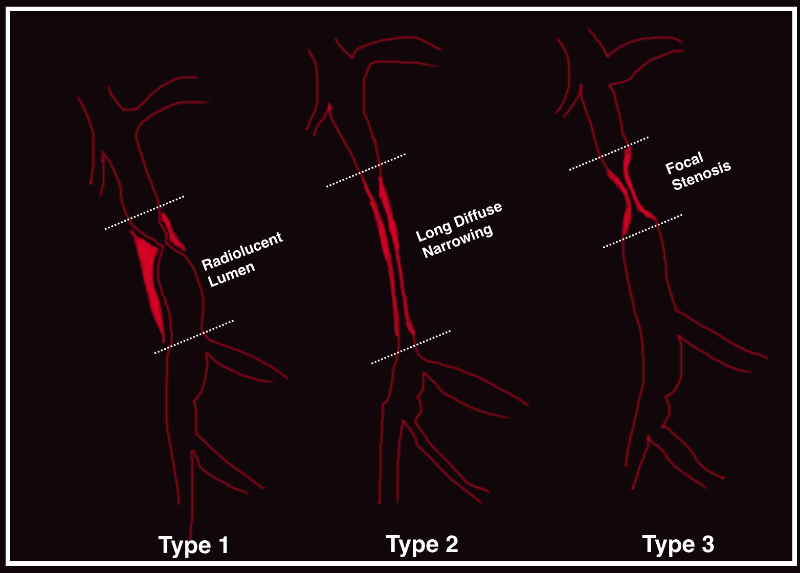Spontaneous coronary artery dissection angiography
|
Spontaneous Coronary Artery Dissection Microchapters |
|
Differentiating Spontaneous coronary artery dissection from other Diseases |
|---|
|
Diagnosis |
|
Treatment |
|
Case Studies |
|
Type 1 Type 2A Type 2B Type 3 |
Editor-In-Chief: C. Michael Gibson, M.S., M.D. [1]; Associate Editor(s)-in-Chief: Nate Michalak, B.A.; Arzu Kalayci, M.D. [2]
Synonyms and keywords: SCAD
Overview
The current gold standard for diagnosing spontaneous coronary artery dissection (SCAD) is coronary angiography, as it is widely available and the first-line imaging modality for patients presenting with the acute coronary syndrome. The predominant angiographic feature of SCAD consists of diffuse smooth narrowing of varying severity involving mid-to-distal coronary segments, secondary to compression of the true lumen and/or expansion of the false lumen by the development of an intramural hematoma. The typical appearance of extraluminal contrast staining, multiple radiolucent lumens, spiral dissection, or intraluminal filling defects is less commonly observed. Other angiographic findings associated with SCAD include coronary tortuosity, myocardial bridging, and coronary fibromuscular dysplasia.
Angiography
Angiographic findings include:[1]
- Type 1: appearance on an angiography involves the presence of two intraluminal streams/lumens separated by a radiolucent flap of the intima.
- Type 2: when the dissection plane is deeper in the vessel wall between the media and adventitial layers, the formation of a hematoma can result in luminal narrowing which is seen as stenosis on angiography.
- Type 3: appearance mimics atherosclerosis. The dissection is typically shorter than that of type 2 (< 20 mm) and may have a hazy appearance. To confirm this type, intracoronary imaging is required. The angiographic findings include linear and long lesion or coronary tortuosity. Another important distinguishing factor from atherosclerosis is the absence of atherosclerosis in the reminder of coronary vessels.
- Type 4: angiographic finding of this type include an occluded artery. The repeat angiography is required to visualize the healed coronary artery and confirm the diagnosis.
Image

References
- ↑ Kim, Esther S.H.; Longo, Dan L. (2020). "Spontaneous Coronary-Artery Dissection". New England Journal of Medicine. 383 (24): 2358–2370. doi:10.1056/NEJMra2001524. ISSN 0028-4793.